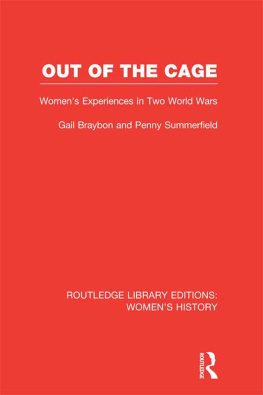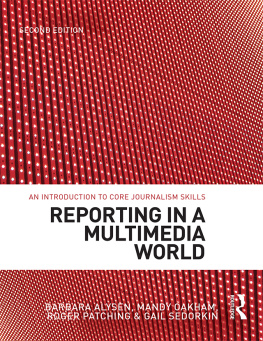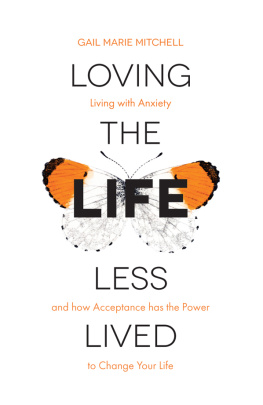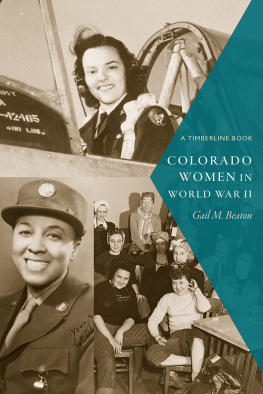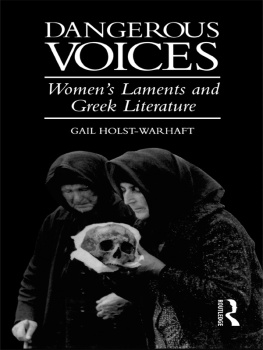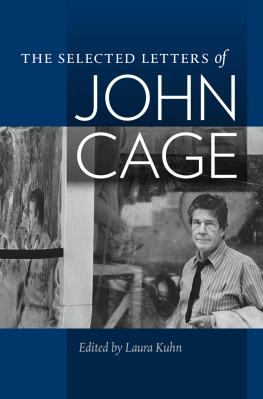ROUTLEDGE LIBRARY EDITIONS:
WOMENS HISTORY
OUT OF THE CAGE
OUT OF THE CAGE
Women's Experiences in Two World Wars
GAIL BRAYBON AND
PENNY SUMMERFIELD
Volume 5
First published in 1987
This edition first published in 2013
by Routledge
2 Park Square, Milton Park, Abingdon, Oxon, OX14 4RN
Simultaneously published in the USA and Canada
by Routledge
711 Third Avenue, New York, NY 10017
Routledge is an imprint of the Taylor & Francis Group, an informa business
1987 Gail Braybon and Penny Summerfield
All rights reserved. No part of this book may be reprinted or reproduced or utilised in any form or by any electronic, mechanical, or other means, now known or hereafter invented, including photocopying and recording, or in any information storage or retrieval system, without permission in writing from the publishers.
Trademark notice: Product or corporate names may be trademarks or registered trademarks, and are used only for identification and explanation without intent to infringe.
British Library Cataloguing in Publication Data
A catalogue record for this book is available from the British Library
ISBN: 978-0-415-53409-3 (Set)
eISBN: 978-0-203-10425-5 (Set)
ISBN: 978-0-415-62267-7 (Volume 5)
eISBN: 978-0-203-10396-8 (Volume 5)
Publisher's Note
The publisher has gone to great lengths to ensure the quality of this reprint but points out that some imperfections in the original copies may be apparent.
Disclaimer
The publisher has made every effort to trace copyright holders and would welcome correspondence from those they have been unable to trace.
OUT OF THE
CAGE
WOMEN'S EXPERIENCES IN
TWO WORLD WARS
Gail Braybon and
Penny Summerfield
First published in 1987 by Pandora Press
(Routledge & Kegan Paul Ltd)
11 New Fetter Lane, London EC4P 4EE
Published in the USA by
Routledge & Kegan Paul Inc.
in association with Methuen Inc.
29 West 35th Street, New York, NY 10001
Set in 10 on 11 pt Sabon
by Columns of Reading
and printed in Great Britain
by Cox and Wyman Ltd
Reading, Berks
Gail Braybon and Penny Summerfield 1987
No part of this book may be reproduced in any form without permission from the publisher except for the quotation of brief passages in criticism
Library of Congress Cataloging in Publication Data Braybon, Gail.
Out of the cage.
(Pandora history)
Bibliography: p.
Includes index.
1. WomenGreat BritainHistory20th century. 2. WomenEmploymentGreat BritainHistory20th century. 3. WomenGreat BritainSocial conditions. 4. World War, 1914-1918WomenGreat Britain. 5. World War, 1939-1945WomenGreat Britain. I. Summerfield, Penny. II. Title. III. Series.
HQ1593.B69 1987 305.40941 87-13510
British Library CIP Data also available
ISBN 0-86358-046-7 (c)
0-86358-228-1 (p)
TO ALINE AND MARJORIE,
AND IN MEMORY OF PADDY
... it was like being let out of a cage....
Lilian Miles, First World War
I thoroughly enjoy my four hours working in the afternoon. I'm all agog to get here. After all, for a housewife who's been a cabbage for fifteen years you feel you've got out of the cage and you're free....
Part-time war worker, Second World War
CONTENTS
ILLUSTRATIONS
PREFACE AND
ACKNOWLEDGMENTS
We first thought of writing a book about women workers in the First and Second World Wars ten years ago. At that time, Gail had just finished her thesis on men's attitudes to women war workers during the years 1914 to 1920, while Penny was halfway through research into various aspects of the Second World War. Stephen Yeo, tutor to both of us while we were undergraduates at Sussex, happened to be the Internal Examiner for Gail's postgraduate work, and the supervisor of Penny's continuing research. Noticing the similarity in our approach to the problems women encountered as war workers (Penny had just published a paper in Capital and Class I, 1977) he suggested we might get in touch with each other, and talk about a book.
This we duly did, as we had remained friends anyway, and we got to the stage of producing a fairly detailed outline, and finding a publisher. There our plans went awry. We were living in very different circumstances, as Gail was unemployed in Sussex, and had plenty of time to get into the project, while Penny was teaching at Durham. What looked just about manageable in the first few months after we signed the contract became rapidly impossible for Penny, as she changed jobs, moved to Lancaster, and had her first baby. We agreed that Gail should see if she could get her work published on its own, while Penny took longer, writing first her thesis, and then a separate book. So, one book on women in the First World War was published in 1981, while the other, on the Second World War, came out in 1984.
That might have been that, particularly as Penny then had numerous teaching and writing commitments, and another baby, while Gail had gone into the world of computing, having been unable to find any work in history. But, we were both disappointed by the fact that our respective books had come out as expensive hardbacks. How many people could afford to buy such things? We still wanted to reach a wider audience, and Gail approached Philippa Brewster, at Pandora, to see if there was any chance of paperbacking her original book. There were doubts about this, and just in passing she mentioned the possibility of writing a new book, with Penny, about women in the two wars this idea was greeted with enthusiasm. All that remained was to let Penny know about the idea! Fortunately, she too was keen, and suddenly the project was live again.
We wrote our plan, and then gradually started writing, amidst the numerous demands of home and work. We already knew that this would have to be rather different from our earlier books, and that we wanted more people to read it than had ever seen our original work. It soon became obvious, as we became immersed in it, that we should use the words and opinions of the women themselves as much as possible. This turned it into a different book altogether: we were not reworking our old material, we were producing something fresh. As a result, this is a companion to our earlier books, not a replacement. We also realised that we were probably producing something far more interesting than our original joint work would have been. We each had greater confidence in our ideas, and knew that we had already put our opinions on the line, in our individual books. We now had more to say, and more sources than had been available 10 years before. We needed all the help we could get, as we were writing 200 miles apart, and squeezing the work in around all the other projects taking up our time! But in the end we really enjoyed producing this book because we felt that women's wartime experiences would be as important to readers as they were to us.
Many people have helped us in this project. Gail would like to thank the librarians at the Departments of Sound Records, Printed Books and Documents, at the Imperial War Museum, for all their help; Sian Jones, of the Southampton City Museums Education Service, and those who organised the Oral History Project on women's war work, namely Jean Berry, Dr Jan Stovold and Jenny Wing, for allowing access to a valuable collection of interviews and photographs; Antonia Ineson, for allowing her to borrow (and quote from) her thesis on women munition workers, and many conversations in the past about women and war; Alan Scott, for telling her when she had done enough work for the day; and Brighton Polytechnic Computer Centre, for allowing her to borrow on numerous occasions, the wonderful Apple Macintosh, which made this book so much easier to write.


